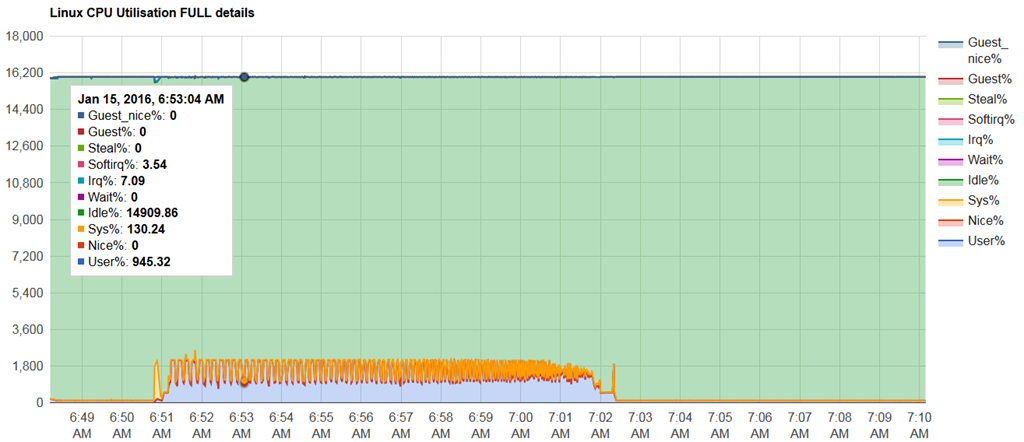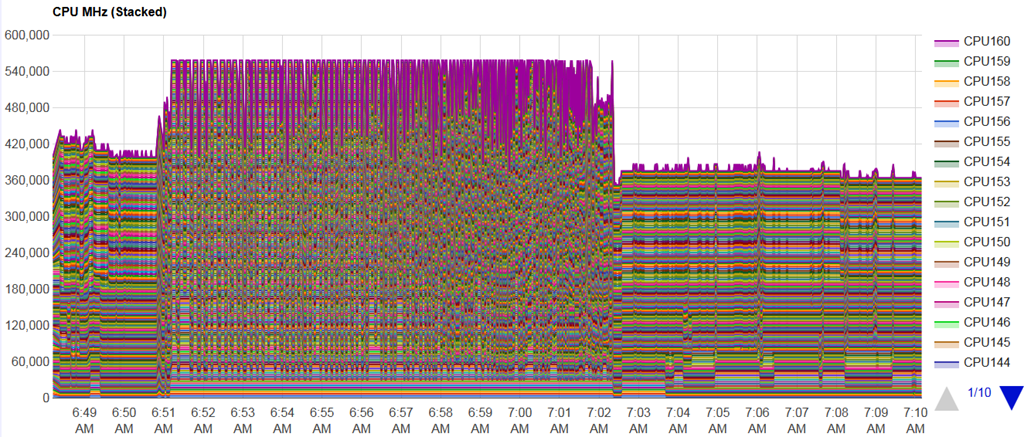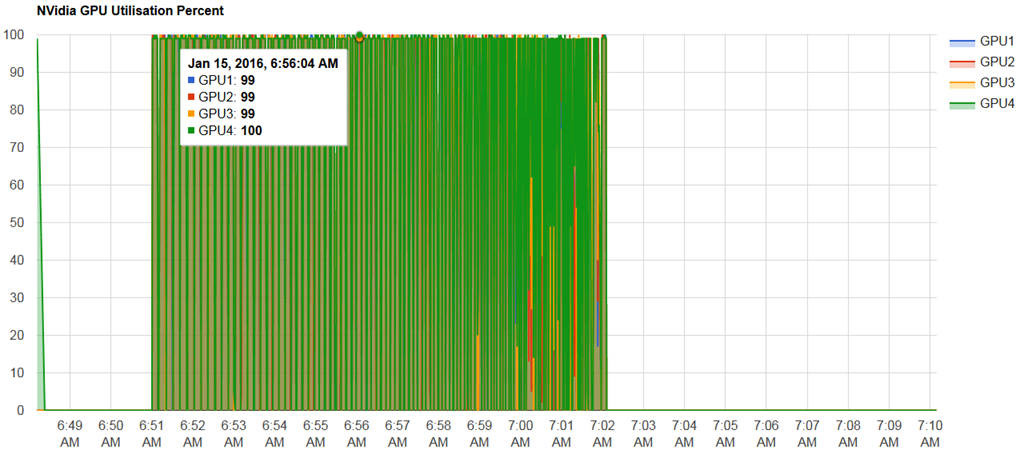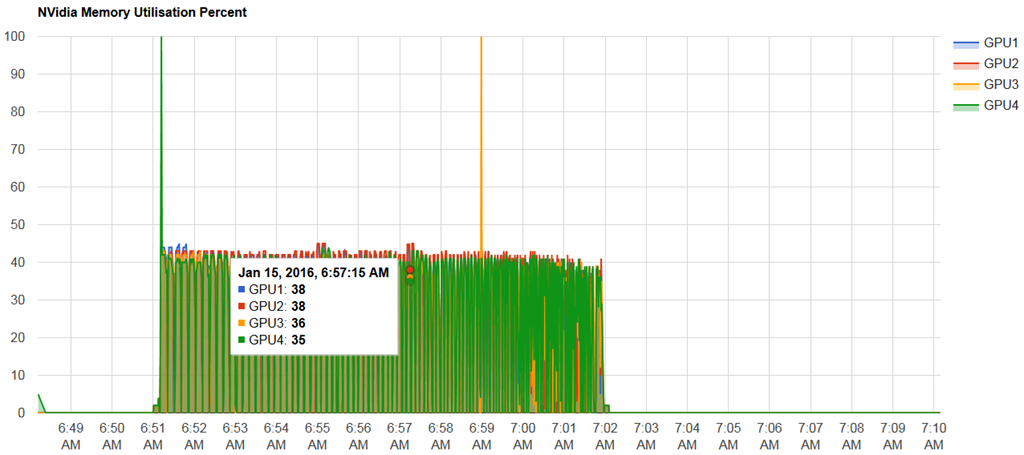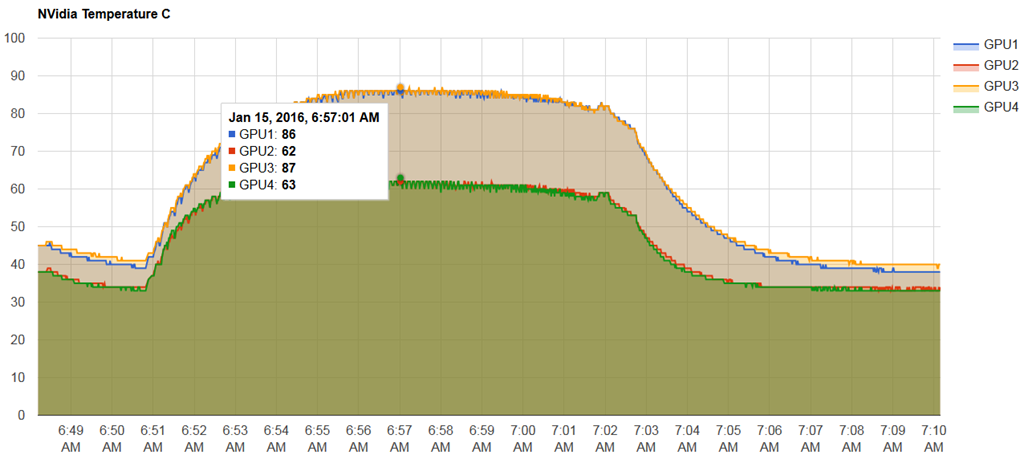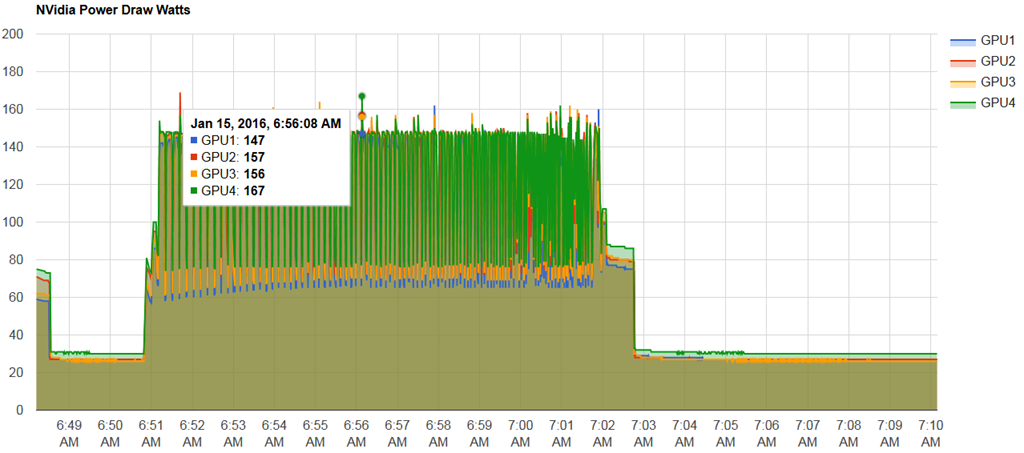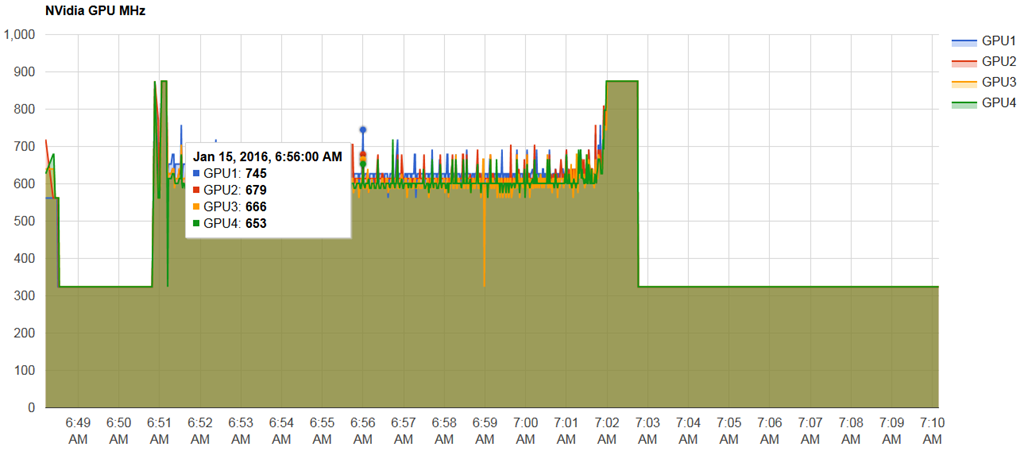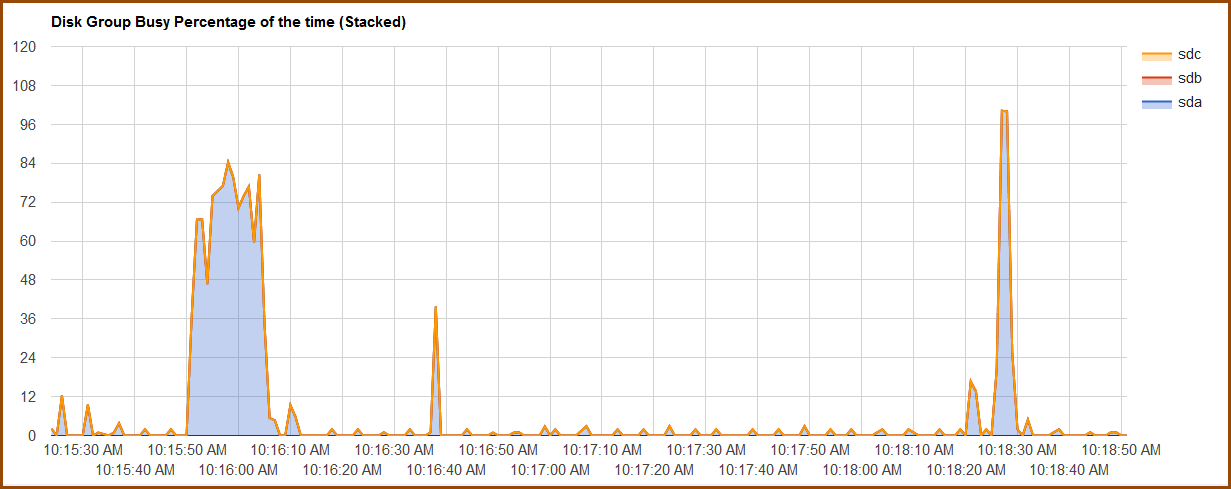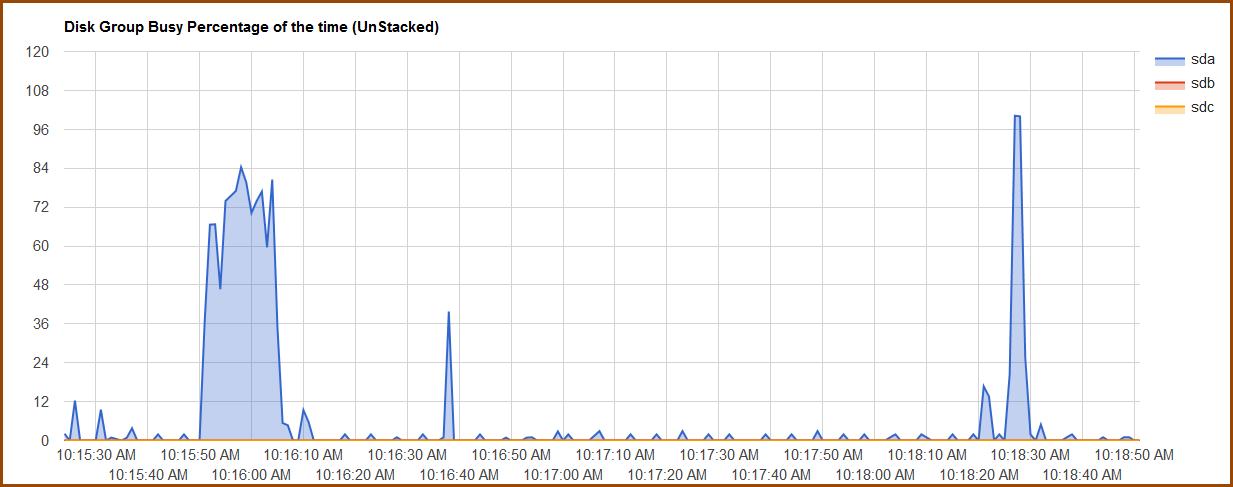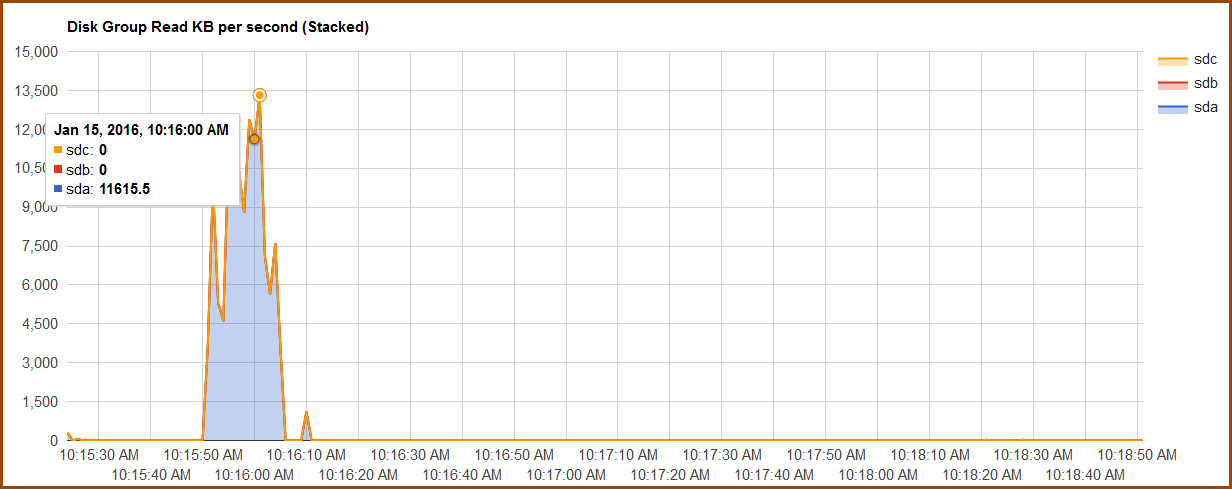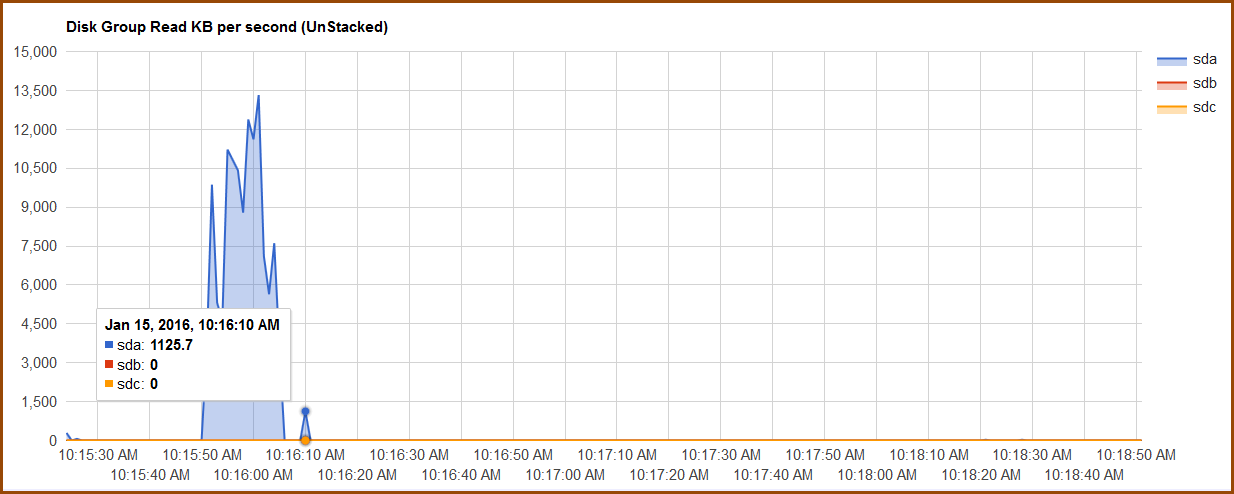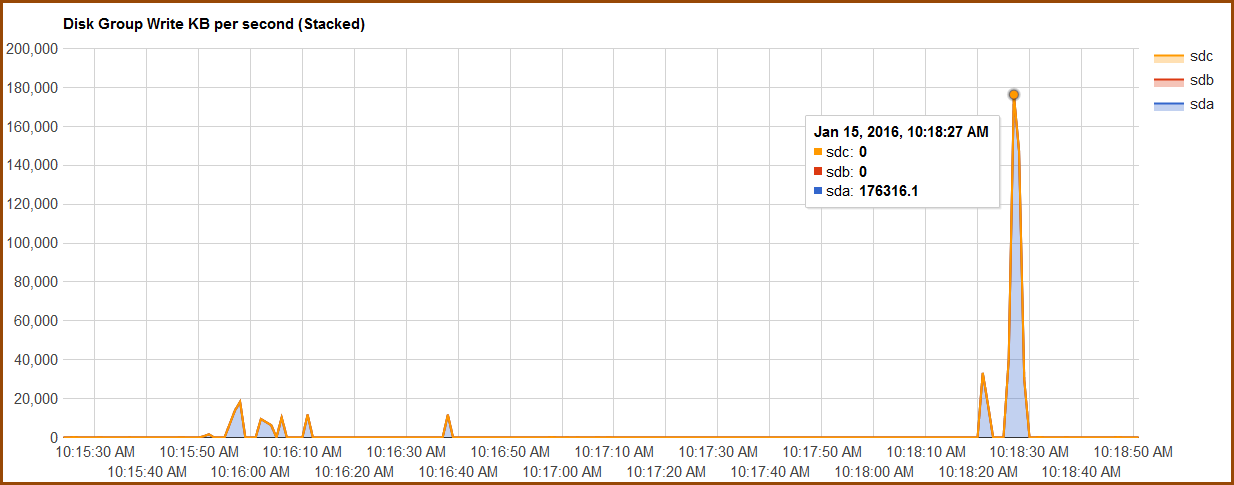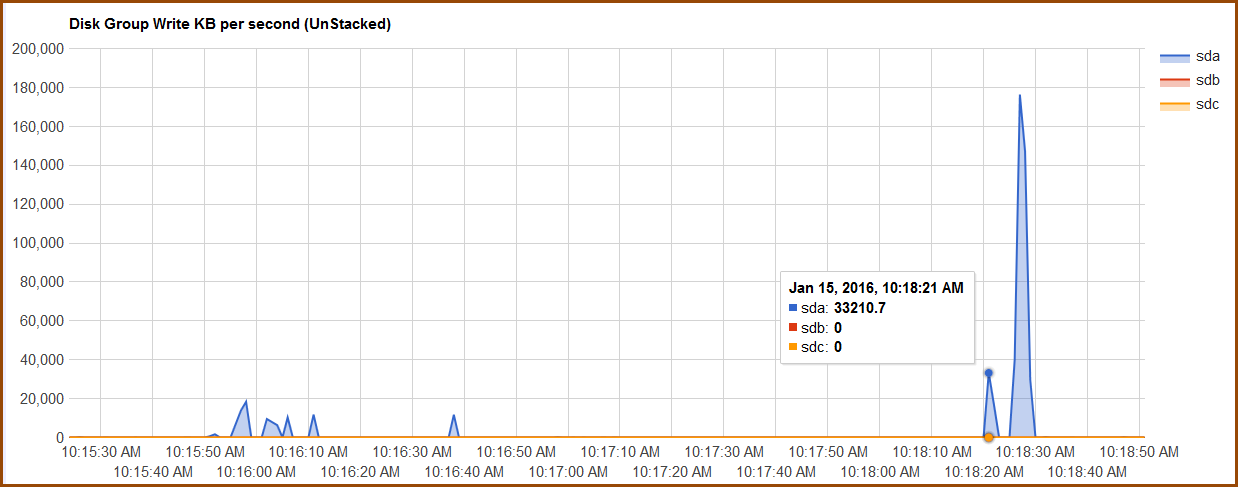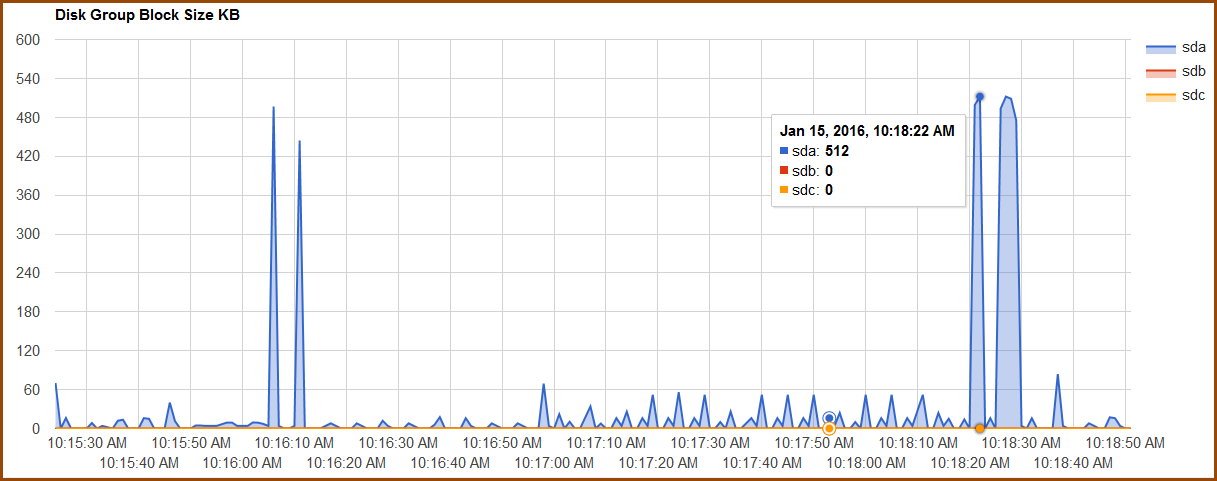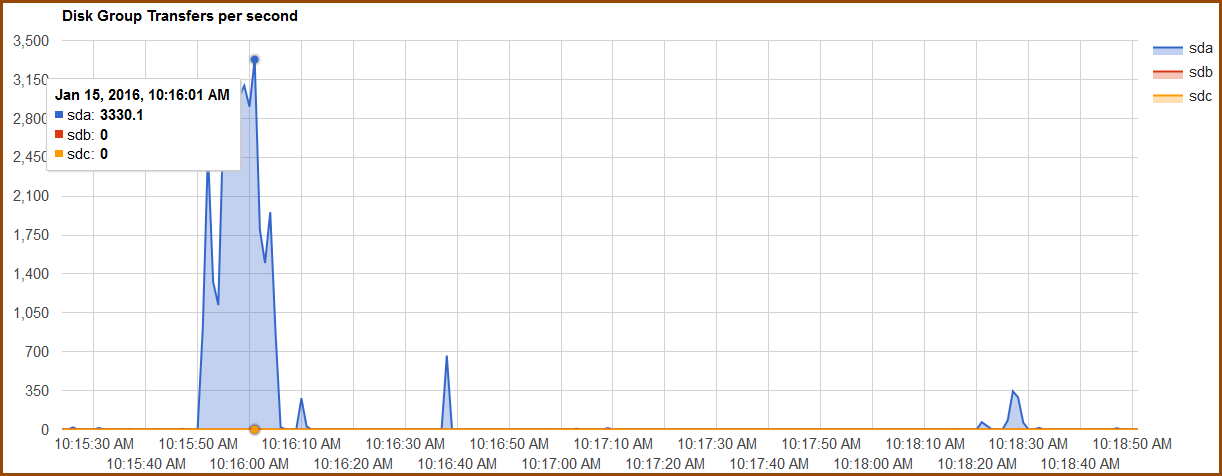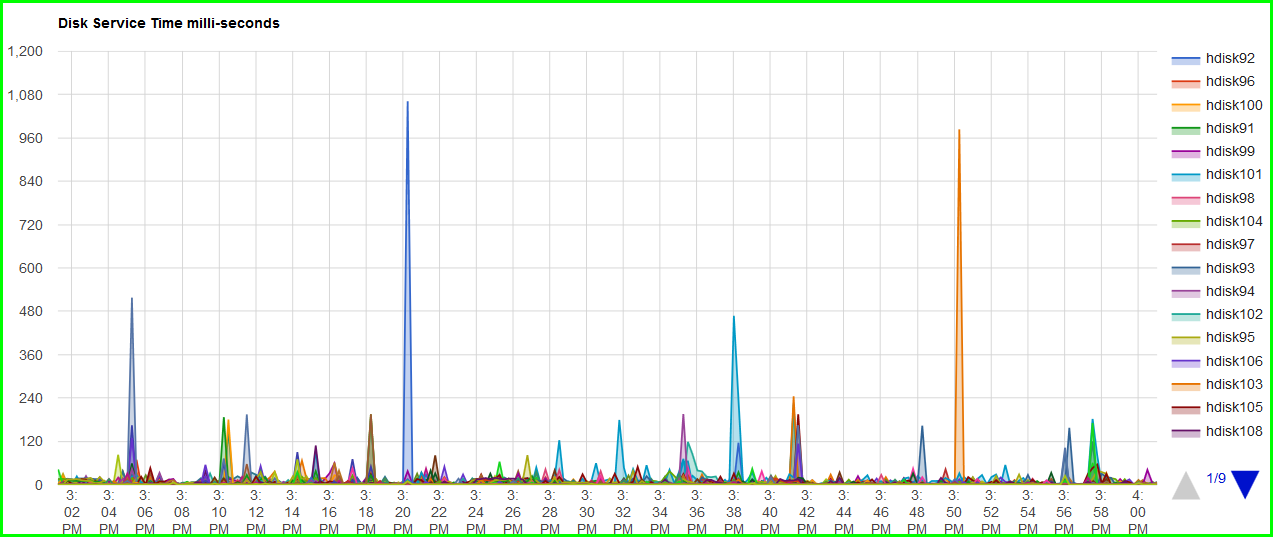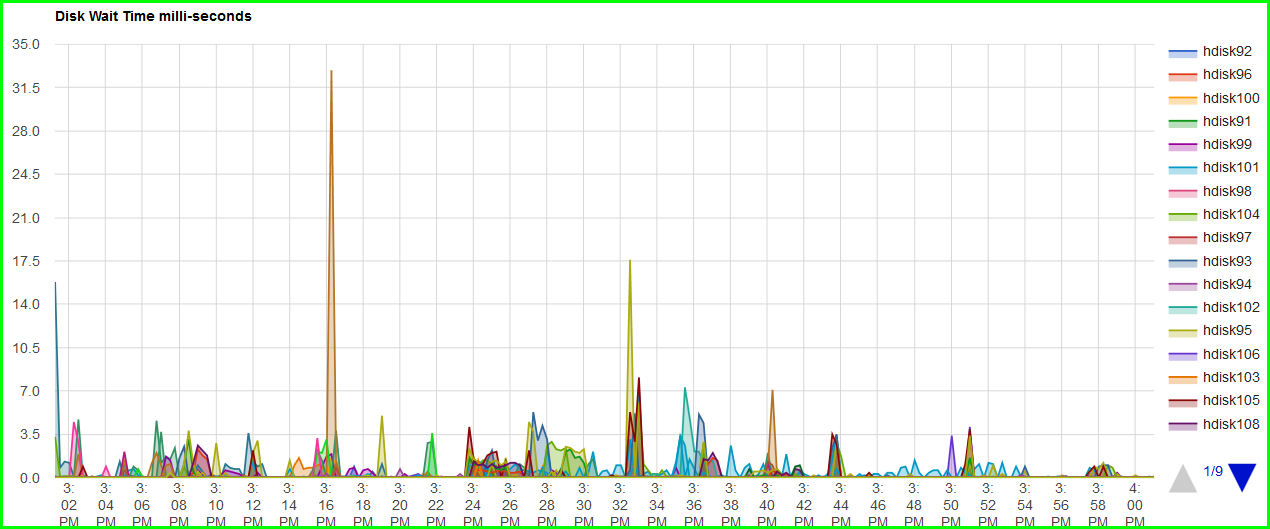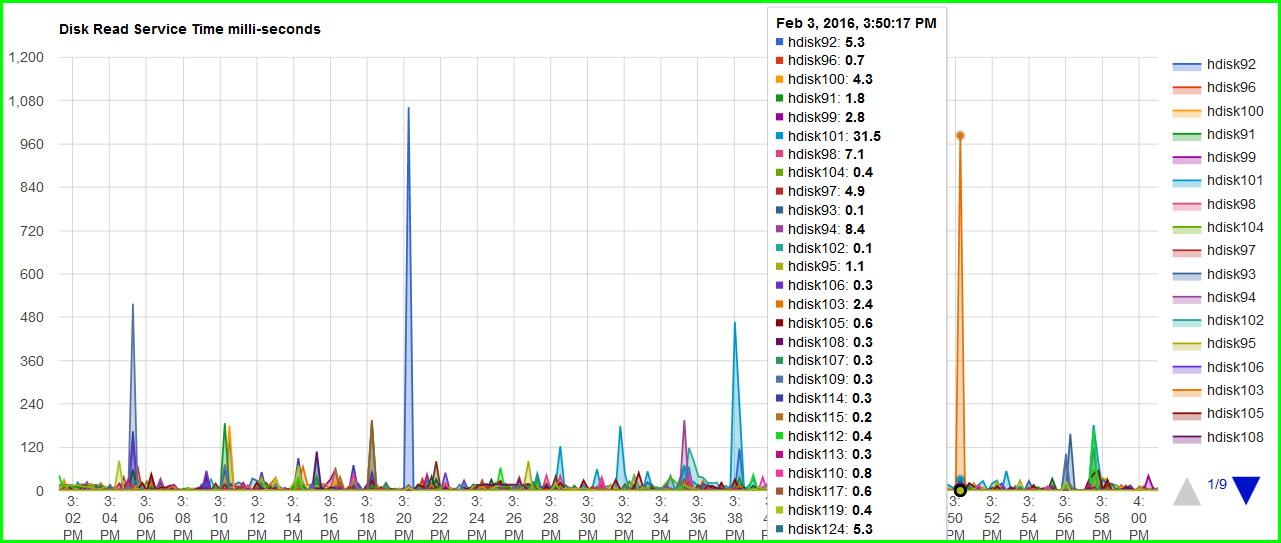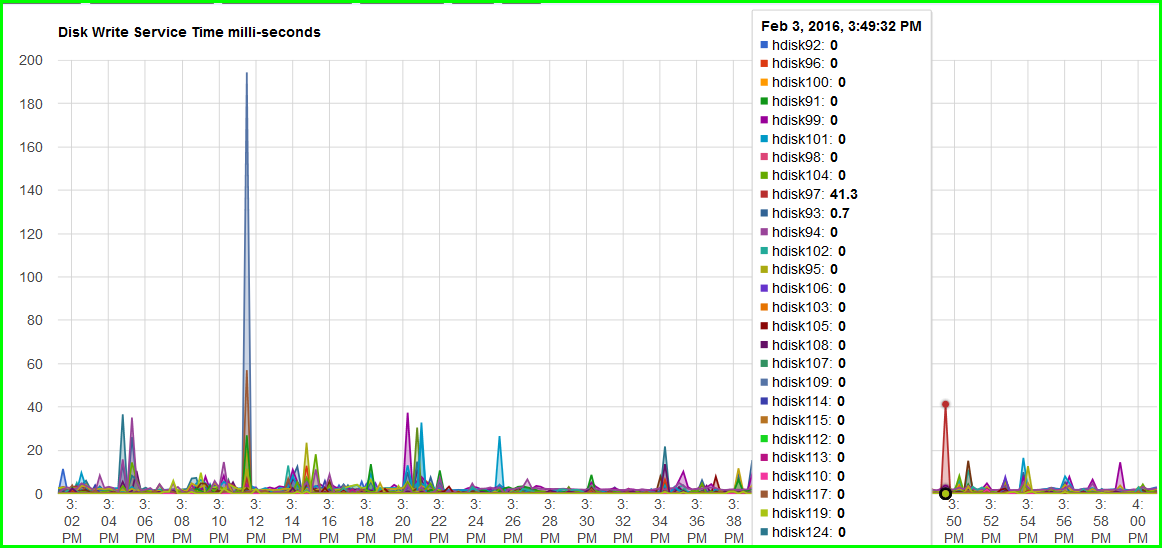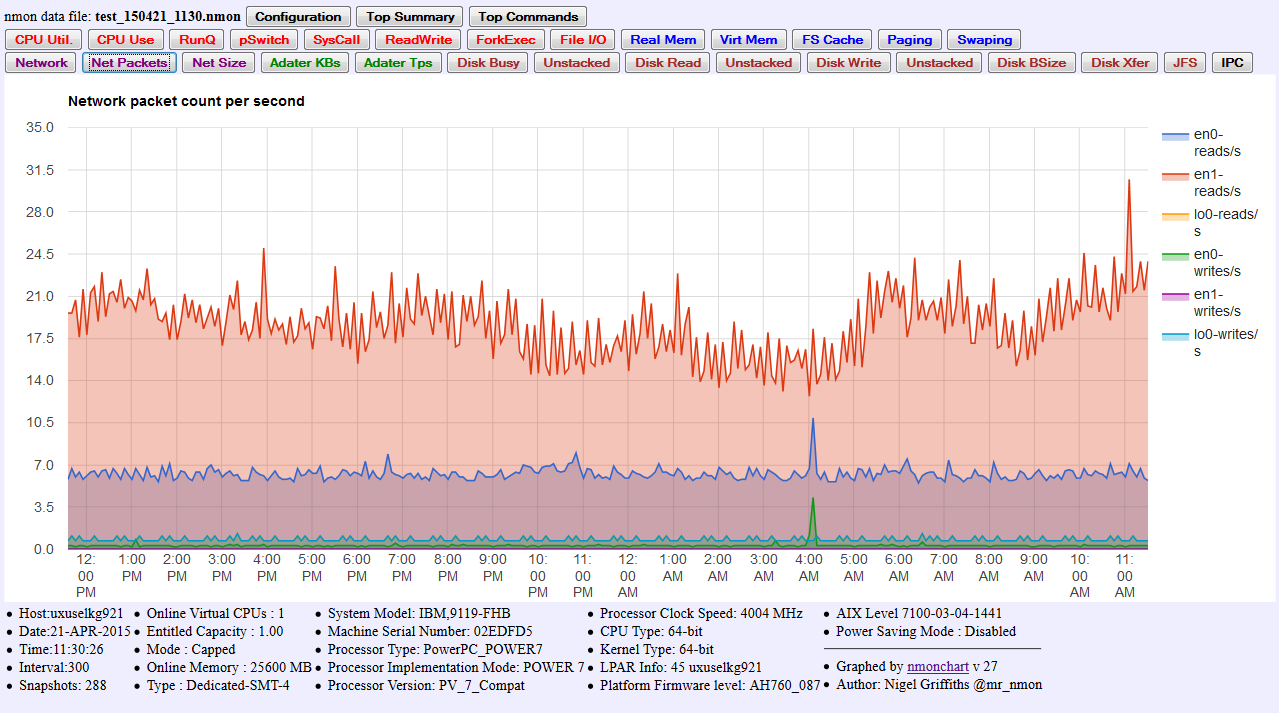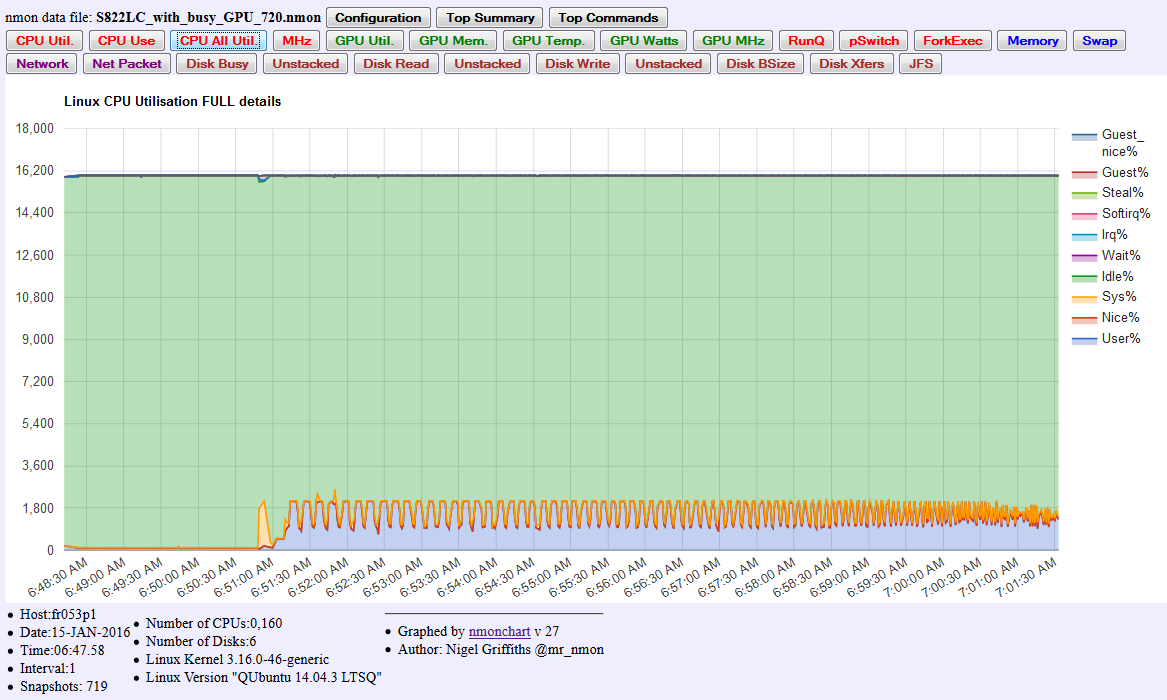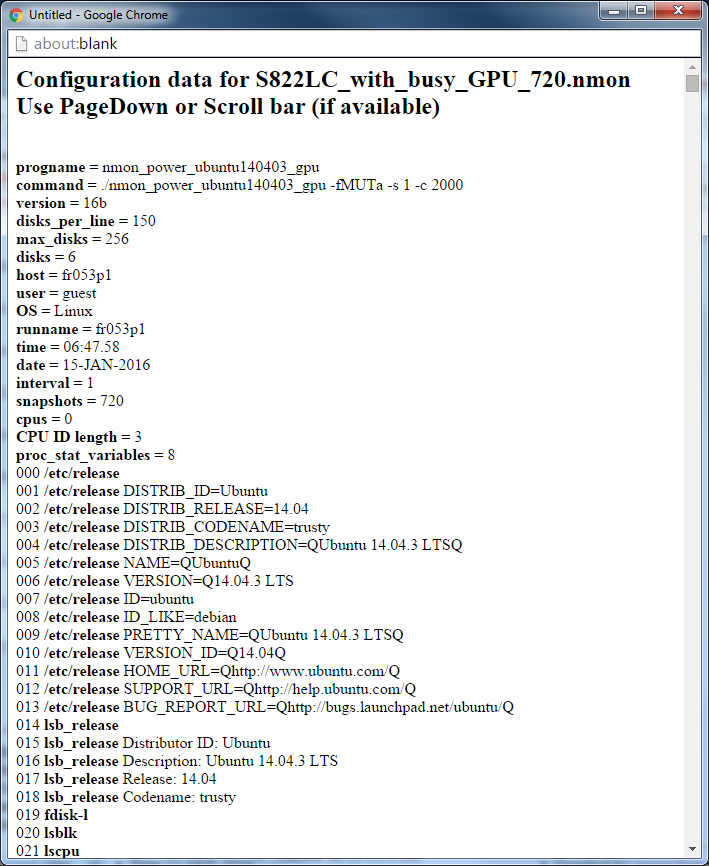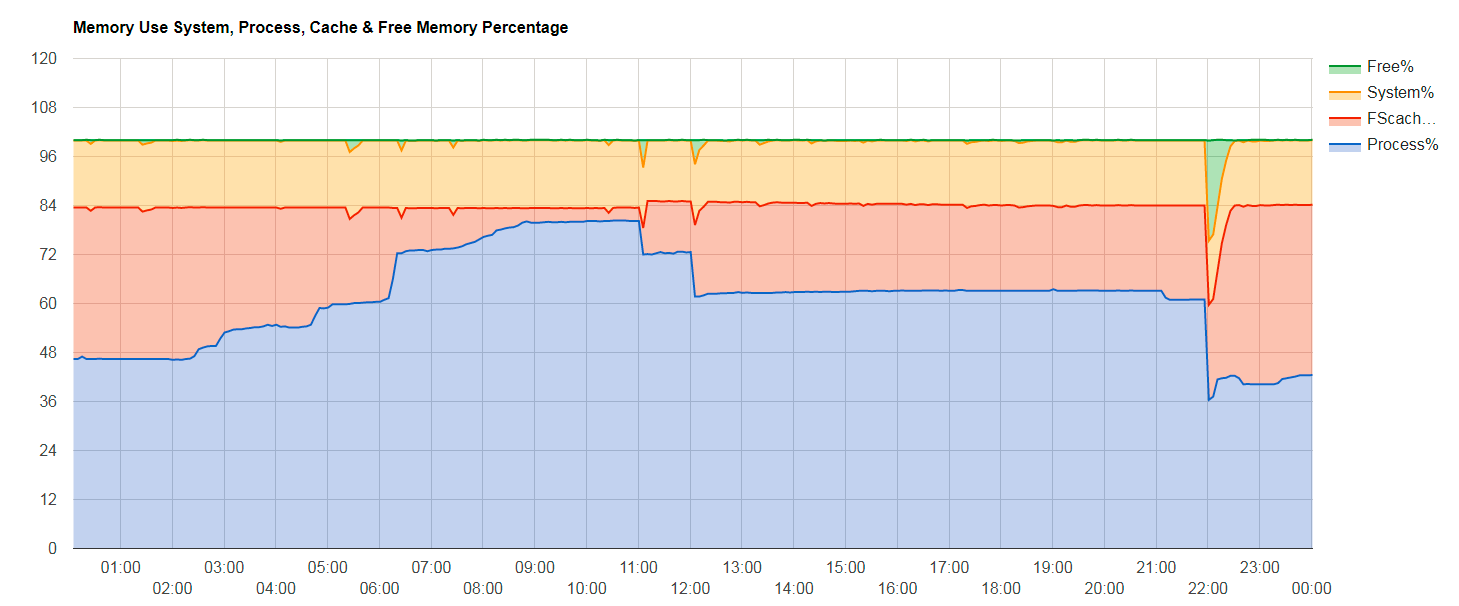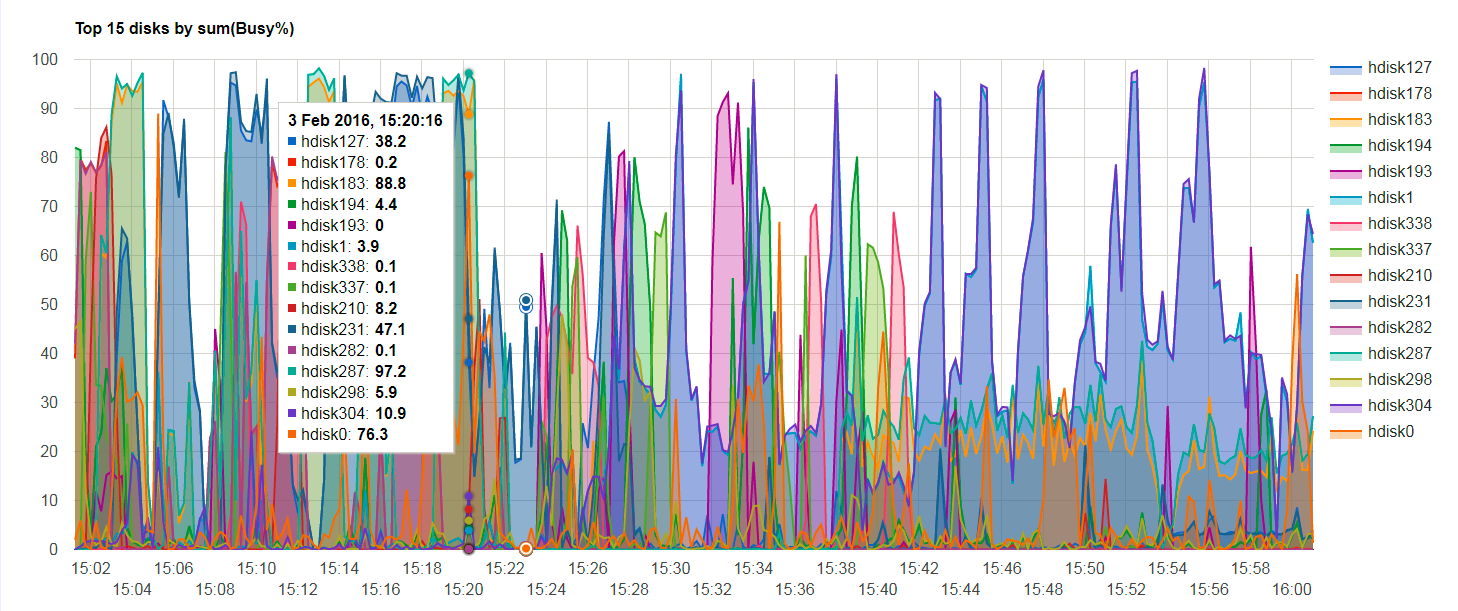Nmonchart
nmonchart - webpage graphs from nmon data
 | nmonchart is a Korn shell script for AIX or Linux to convert nmon collected files to a webpage (.html) including Google Chart and JavaScript to display the top 60+ AIX and Linux Performance Graphs and configuration details |
Syntax:
nmonchart <nmon-file> <output-file>.html
For example:
nmonchart blue_150508_0800.nmon blue_150508_0800.html
New:
nmonchart blue_150508_0800.nmon- if you miss out the output filename is will use the source filename and replace .nmon with .html
Or you could put the .html straight on to your website (assuming Apache is using /var/www/html)
nmonchart blue_150508_0800.nmon /var/www/html/blue_150508_0800.html
Online Immediate nmonchart generated graphs - a Website on the Internet
- Don't want to download code, run KSH scripts on AIX or Linux? To much like hard work?
- Use the online service:
- Upload your nmon file using your browser
- . . . Wait a couple of seconds
- Your browser gets send the graphs
- Job Done!
- Currently this is running at https://mr-nmon.com/nmonchart.html
- This is running on a Nigel's Raspberry Pi 400
Here is a simple small sample file so you can see what the graphs look like:
- sampleC.html - small sample and quick to load but some data faked to make the graphs look good (not largely full of zeros).
- sampleD.html - large real-life sample and can take a few seconds to load
- Used the nmonchart like this:
- ./nmonchart sampleC.nmon sampleC.html
- ./nmonchart sampleD.nmon sampleD.html
- Both of these and the original .nmon files are in the download files below for you to try.
Note:
- IBM Lab Services regularly uses nmonchart to perform Power Systems Health-Checks (among many other tools).
- As a service you get a System Admin / Performance specialist at your site to make tuning recommendations about your Power Server(s).
- And they can show you how to install and use nmonchart.
|
Haven't got access to AIX or Linux! Don't worry you can use VirtualBox to run Ubuntu for free on you PC or Laptop:
On Ubuntu, run nmonchart as below: ./nmonchart samepleC.nmon |
Below are:
- The download details on the nmonchart .tar file (4 MB) including history of updates
- Gallery of the graphs produced (click on the small images for details)
- The README for the latest version(included in the download package)
Downloads
| Download File | Comments |
| nmonchart43.tar | Current Version 43 - 10th Feb 2025 New Features of nmonchart version 43 - Apple macOS support and other strange UNIX flavours with ksh with a strange directory - LARGE nmon files = meaning more than 9999 snapshots in a file. -- Big thanks to Ivor Goncharov for these code fixes and advanced awk options. -- Change to awk that deals with Timestamps to use RSTART & RLENGTH which allows Timestamps more than T9999 i.e. four digits. - Note: use "nmon -w digits" option (now also available in nmon for Linux 16r onwards) to set the number of digits in the Timestamp (T numbers used in ZZZZ lines). -- Suggest: -w 6 for up to 999999 snapshots. -- This stops ordering problems on T9999 to T10000 boundaries & T99999 to T100000 etc. Graphs of 10,000 datapoints with a screens of 1920 pixel wide is "challenging"! -- But does work now, thanks to Ivor - the screen updates can take a few seconds. - Clean up one large sed command for readability and small correction. |
| nmonchart42.tar | New Features of nmonchart version 42 - Support for AIX Volume Groups stats. Example graph: nmonchart42_volumegroup.jpg - This requires capturing with the nmon -A option on AIX. - Small bug fixes to handle some odd formatting in nmon files. |
| nmonchart40.tar | New Features of nmonchart version 40 - Support for VIOS SEA, VIOS SEA Packet and VIOS SEA Physical Network. Example: redvios1.html - This requires capturing with the nmon -O option on the VIOS. - These and Fibre Channel (FC) stats buttons go on a new line - if found in the .nmon file. - Change the threshold from 5.0 to 0.05 on CPU_USE graphs. |
| nmonchart39.tar | Old Version 39 - 19th Nov 2019 New Features of nmonchart version 39 - Support for AIX 7.2 TL4+ CPUMHZ stats (Higher MHz used in CPU Max Mode on POWER9). - Note: you must add the -y dfreq=on to the end of the nmon command line |
| nmonchart38.tar | Old Version 38 - 12th Oct 2019 New Features of nmonchart version 38 - Added Disk Transfer (DISKXFER) graph to have both Stacked and Unstacked graphs - Clearer Zoom In/Out details |
| nmonchart37.tar | Old Version 37 - 13th Sept 2019 New Features of nmonchart version 37 - Correction to the Paging rate graph title (thanks to Alan Wilcox for reporting this confusion) to -- "All Paging (pgin & pgout) & Paging from Paging Space only (pgsin & pgsout) per second" - Change Logical CPU USE (SMT) to ignore values below 5% -- highlights real use of the SMT threads + new title & ignores SMT threads which are just ticking over -- change graph title to explain this Average Use of Logical CPU Core Threads POWER=SMT or x86=Hyperthreads (ignoring values below 5%) - Typo transers to transfers |
| Removed | Version 35 - 13th Feb 2019 - Good speed up in performance - especially with large numbers of snapshots - thanks to Klaus Franke - Added four AIX Fibre Channel Graphs by request. Note you need to run nmon with the -^ to include FC stats. -- FC READ & WRITE KB/s and FC TRANSFERS IN and OUT/s - Removed the need for the 2nd parameter. It uses the 1st parameter & will replace the .nmon with .html -- If not ending in .nmon it just added the .html anyway. |
| Removed | Version 34 - 4th July 2018 - Fix to TopDisks by adding the paste command -d, option - Added to Linux nmon files from PowerVM (POWER hypervisor) PhysicalCPU and Shared CPU Pool Free graphs - Thanks to Enrico Joedecke for the above fix and suggestion - For Linux the RunQueue graph includes Blocked processes - JFS data "nan" short for "not a number" (usually not a real filesystem) replaced with -1.234 so graphs work |
| Removed | Version 33 - 4th Nov 2017 - Added Top 15 Disks Graph - particularly useful if the data has 100's or 1000's of disks |
| Removed | Version 32 18th Oct 2017 - Added for AIX a new memory graph for System%, Process%, Cache% and Free%. Note: in the nmon Analyser it is the MEMNEW graph. - Added handling for single GPU (normally in pairs) |
| Removed | Version 31 - 9th Dec 2016 - Fix for Top Processes sort arguments for Linux which handles -t, differently resulting in not having the Top 20 processes on Linux. - Fix Linux machines with no disks reported in AAA,disks,0 line - we skip graphing the disks. - Added sampleD.nmon and sampleD.html as a much larger & more interesting set of nmon stats. - Note: sampleC had some stats faked up my me! |
| Removed | Version 30 - 22nd Sept 2016 Fix for running the nmonchart Ksh script on Linux. AIX has "print -n" option but Linux does not. |
Gallery
README for nmonchart 42 by Nigel Griffiths
==========================================
The Korn shell script file nmonchart transforms .nmon performance capture files into .html files for a webserver site.
If your .nmon is called hostname_date_time.nmon and the website pages are at /webpages/docs then use it like this:
./nmonchart hostname_date_time.nmon /webpages/docs/hostname_date_time.html
Alternatively, script the second parameters and the output file name is the first parameter but the .nmon is changed to .html
Then nmonchart script needs the Korn shell installed (ksh). nmonchart has NOT been tested with sh, Csh or bash. These are not supported. AIX and Linux have Korn Shell called ksh, If your Linux does not have ksh, you should install it.
The script works out if it is running on AIX or Linux and makes two changes based on that. For details check the top of the script.
nmonchart is complex as it is 1600 lines long. Mostly due to supporting so many grapsh with roughly 10 to 10 lines per graph.
nmonchary is a fairly simple Korn shell mostly using grep, sed and awk. The awk can get a little complex.
For performance data n the nmon file in a fixed column format like
physical CPU, run queue and memory stats
it is simple to pick out the column names and data columnsand graph it.
For data that is not fixed format as it depends on the variable numbers of
resources like disk, network, CPUs the code is more complex.
It has to workout the number of resources and the names from the header
line and then process tha number of columns from the data lines.
The graphs like TOPSUM and TOPCMD are quite tricky and the database has to be calculatelt, listed orders and selected fro other data.
For testing included in the package there is a supplied sample nmon file
called: sampleC.nmon and a sample output file called: sampleC.html
The .html file swas create like this:
./nmonchart sampleC.nmon
The same goes for sampleD.nmon
Examine the sampleC.html to find out how it contains the data and how it
it generates the graphs inside you web browser:
It is coded in Javascript
Which called the Googlechart library (directly from the web) to generate
the graphs
- find more information here https://developers.google.com/chart/
- it has lots of functions and makes beautiful graphs
For each graphs
- The data in Javascript array format and the ZZZ data transformed into
a Javascript date format
- Thee is also chart drawing options and graph type instructions
At the bottom of the script it creates the Javascript buttons and
then the config data that is displayed at the bottom of the webpage.
Output file size
Note nmonchart output files (.html) are typically much smaller than the
original nmon file. Something like 20% of the size.
Large .nmon files will take longer to process & display but should finish.
This is unlike the nmon Analyser Excel files output which can typically
be twice the sizeas the original .nmon file.
New Features of nmonchart version 42 - Small bug fixed for handling unusual data. - AIX Volume Group stats are graphed: VG Busy%, VG rea & write KB/s,
VG Block Size and VG Transfers/s. The buttons are grey.
New Features of nmonchart version 40 - Support for VIOS SEA, VIOS SEA Packet and VIOS SEA Phyiscal Network - This requires capturing with the nmon -O option on the VIOS - These and FibreChannel (FC) stats buttons go on a new line
- if found in the .nmon file.
- Change the threshold from 5.0 to 0.05 on CPU_USE graphs.
New Features of nmonchart version 39 - Support for AIX 7.2 TL4+ CPUMHZ state if you add the -y dfreq=on flag
on POWER9+
New Features of nmonchart version 38 - Added Disk Transfer Stacked graph - Changes Zoom in/out wording
New Features of nmonchart version 37 - Correction to the Paging rate graph title to
"All Paging (pgin & pgout) & Paging from Paging Space only (pgsin & pgsout)
per second"
- thanks to Alan Wilcox for reporting this confusion
- Change Logical CPU USE (SMT) to ignore values below 5%
- the highlight real use of the SMT threads + new title
- ignores SMT just ticking over
- change graph title to explian this
Average Use of Logical CPU Core Threads - POWER=SMT or x86=Hyperthreads
(ignoring values below 5%)
- Typo transers to transfers
New Features of nmonchart version 35 - thanks to Klaus Franke for the
speed up code snippet
- Good speed up in performance - specially with large numbers of
snapshots (i.e. many thousands)
- Added four AIX Fibre Channel Graphs by request. Note you need to run
nmon with the -^ to include FC stats. FC READ & WRITE KB/s and FC TRANSFERS IN and OUT/s
- Removed the need for the 2nd parameter - it uses the 1st parameter &
will replace the .nmon with .html If not ending in .nmon it just added the .html anyway.
New Features of nmonchart version 34 - thanks to Enrico Joedecke for
the fix and suggestions
- Fix to TopDisks by adding the paste command -d, option - Added to Linux nmon files from PowerVM (POWER hypervisor) PhysicalCPU
and Shared CPU Pool Free graphs
- For Linux the RunQueue graph incldes Blocked processes - JFS data "nan" short for "not a number" (usually not a real filesystem)
replaced with -1.234 so graphs work
New Features of nmonchart version 33 - Added the Top 15 Disks graph - button on the top line - Top disks are determined by the sum of all the Busy percentages for each disk - Short lived peaks to high percentages may not appear as a busy disk - This top 15 disks can help when the nmon file has many tens to houndred
or thousands of disks.
New Features of nmonchart version 32 - Added the AIX MemUse graph for Process%, File system cache%, System%, Free% - Added handling of Linux GPU, if there is just one GPU
New Features of nmonchart version 31 - Fix for Top Processes sort arguments for Linux which handles -t, differently - Fix Linux machines with no disks reported in AAA,disks,0 line
- we skip graphing the disks
- Added sampleD.nmon and sampleD.html as a much larger & more interesting
set of nmon stats
- Note: sampleC had some stats faked up my me!
New Features of nmonchart version 30 - work around differences of echo and print for AIX and Linux - see PRINTN
in the script.
New Features of nmonchart version 29 Zoom In and Out added - thanks to Ivan Goncharov for the hint - Left-click and drag the mouse to highlight an area to Zoom then when
you let go it will Zoom In
- Right-click to Reset and see the whole graph again
New Features of nmonchart version 28 1) Added PROCCOUNT (count of processes) as this was release via an
AIXpert Blog about nmon Extermal Data Collectors
2) Added MORE1 and MORE3 examples for people adding their own stats. 3) Buttons for adapter typo fixed
New Features of nmonchart version 27 The buttons labels are upper and lowercase = look nicer Added the nmon Configuration button to pop-up a window with the AAA & BBB data Unfortunately, this highlights browser behaving differently - Firefox no scroll bars so use PageDown - Chrome has scroll bars - Internet Explorer I get a blank windows but it works for other people The Top Process Summary and Top Commands Buttons moved up at the top
line to save space
If you do not want the Config button (it does add to the .html size)
set wantCONFIG=0 near the top of the nmonchart script - =1 means we want it.
New Features of nmonchart version 27 1) Better Configurtion button support 2) Top Commands bubble diagram and graph move to the top line 3) Graph title improvements and clarification 4) Buttons in mixed case for readability 5) Link to nmonchart download and information website
New Features of nmonchart version 26 - not released
New Features of nmonchart version 25 Added the following AIX Disk Service time stats which are collected
if you add the nmon -d option
In the nmon file these lines start with
DISKSERV DISKREADSERV DISKWRITESERV DISKWAIT
- Disk Service time in milli-seconds - Disk Read Service time in milli-seconds - Disk Write Service time in milli-seconds - Disk Wait time in milli-seconds
New Features of nmonchart version 24 1) Disk Groups Now supported User Defined Disks Groups data. nmon -g filename
or nmon -g auto
- This is particularly good for nmon for Linux ae -g auto will remove
all the disk + partition duplication
- In the data frile look for likes starting like DGBUSY etc. - Also very good to group your disks like database, backup, dump,
or rdbms_log, rdbms_data
- New Graphs
DGBUSY - Disk Group busy percentage for each disk - Stacked lines
DGBUSYu - Disk Group busy percentage for each disk - Unstacked lines
DGREAD - Disk Group read throughput in KBytes per second for each disk
- Stacked lines
DGREADu - Disk Group read throughput in KBytes per second for each disk
- Unstacked lines
DGWRITE - Disk Group write throughput in KBytes per second for each disk
- Stacked lines
DGWRITEu - Disk Group write throughput in KBytes per second for each disk
- Unstacked lines
DGSIZE - Disk Group block sizes
DGXTER - Disk Group Transfers per second
2) S822LC can have NVidia GPU adapters - A special nmon version 16c to capture, GPU stats: GPU Util, Memory Util,
Temperature, Watts and GPU MHz
- In the data look for lines starting with GPU_ - Note each adapters has two GPUs so a total of four - New Graphs
GPU_UTIL - NVidea GPU Stats, GPU CPU Utilisation percent
GPU_MEM - NVidea GPU Stats, GPU Memory Utilisation percent
GPU_TEMP - NVidea GPU Stats, Temperature in degrees Centigrade
GPU_WATTS - NVidea GPU Stats, input electrical power in Watts
GPU_MHZ - NVidea GPU Stats, GPU Mhz
3) Linux Utilisation stats now ten of them - Linux now has ten utuilisaiton stats: user, nice, system, ide, wait for IO,
steal, irq, soft irq, guest and guert nice
- nmon for LInux 16c onwards captures these - Note a CPU core thread is reported as 100% otherwise machines with
160 only ever reports tiny percentages.
- New Graph
CPUUTIL_ALL
Not included the data for each CPU core thread
- my machines have up to 160!!!
Summary of the graphs
PHYSICAL_CPU - PhysicalCPU, VirtualCPU & entitlement (AIX only LPAR stats))
POOLIDLE - If switched on at the LPAR level PoolIdle & Pool CPU count
(AIX only
CPU_UTILisation - User%, System%, Wait% and Idle%
CPU_USE - Logical CPU Core Use (Power SMT or x86 Hyperthreads)
Average(User%+System%)
RUNQ - Run Queue in number of processes
PSWITCH - Process Switches as the kernel runs different programs
SYSCALL - Systems calls of processes requesting Kernel operations
- Total and read, write calls
READWRITE - Read and Write System calls only
FORKEXEC - Systems call fork (duplicate a process) and exec
(overwrite current process with a new program)
FILEIO - System call - number of bytes on the read + write system call
- includes disks, network sockets and pipes
REALMEM - Total RAM (MB) and Free RAM (MB) (AIX only)
VIRTMEM - Virtual memory (paging space) Total (MB) and Free (MB) (AIX only)
MEM_LINUX - Total RAM, Free RAM (MB), and other Linux memory stats
(Linux Only)
SWAP_LINUX - Swap size (MB) and Swap Free (MB (Linux only)
FSCACHE - Filesystem Cache (numperm) size in percent with minperm%
and maxperm% (AIX only)
PAGING - Paging space: pages in (pgin) and out (pgout) plus Filesystem
paging: in (pgsin) and out (psout)
SWAPIN - Process swap back in to memory per second
TOPSUM - If your nmon file includes TOP process (nmon -t or nmon -T)
- Bubble diagram of top process by total CPU cycles, total I/O KB
and max Memory size
- horizontal axis = CPU cycles in total
- vertical axis the I/O generated this could be network, disk,
pipes, sockets
- size of the bubble is the memory size
TOPCMD - If your nmon file includes TOP process (nmon -t or nmon -T)
- top 15 commands and their CPU use over time.
NET - Network throughput read & write for each network in KByes per second
NETPACKET - Numbers of read & write packets per second for each network
NETSIZE - The average number of bytes in each packet for each network
ADAPT_KPS - Throughput in KBytes per second read & write for each disk
adapter
ADAPT_TPS - Transactions per second read and write for each disk adapter
DISKBUSY - Disk busy percentage for each disk - Stacked lines
DISKBUSYu - Disk busy percentage for each disk - Unstacked lines
DISKREAD - Disk read throughput in KBytes per second for each disk
- Stacked lines
DISKREADu - Disk read throughput in KBytes per second for each disk
- Unstacked lines
DISKWRITE - Disk write throughput in KBytes per second for each disk
- Stacked lines
DISKWRITEu - Disk write throughput in KBytes per second for each disk
- Unstacked lines
DISKBSIZE - Disk block sizes
DISKXTER - Disk Transfers per second
JFS - Journaled Filesystem Percent Full
IPC - Interprocess Communication meaning Semaphores and messages queues.
Graphs not supported
More than 150 Disks - You have the adapter view for overall Disk stats.
Data files with crazy numbers of disks in the thousands are just
impossible or graph or manage (IMHO). Please rethink or disk strategy
and get the storage subsystem to do the work and not you.
The first 150 plus top 20 plus the adapter totals is a good compromise.
Graphs that are not going to happen and why
Individual Logical CPU Utilisation also called CPU core threads
- up to 1920 with the new Power10 E1080 with 140 cores)
Mostly pointless and misleading - they are timesharing the
physical CPU cores.
Better to study the VM LPAR physical CPU use and UTIL graphs.
Adding new graphs - I am interested in hearing you ideas on new graphs you would like to have. - They need to add value for most nmon users - Adding graphs from the nmon file is pretty easy as we have
already worked though the issues of most formatting options
- So it is a cut'n'paste rename the graph and make minor formatting changes
for the column, don't forget the button lines at the bottom.
- Yet more disks graphs for stupidly high numbers of disks is not a good idea.
nmonchart created webpages or Graph failures
If you transform the nmon data but the webpage does not work -
What should you do?
1 Feel free to send me the original nmon file to investigate 2 Mostly, the webpage will probably display OK but the buttons will not work 3 Javascript and Google charts are rather fussy in the syntax 4 Sometimes the first few graphs work but later in the page ones will
not do anything - this is a good indicator of where the syntax issue
is in the file.
5 If something like the number of disks changes during the collecting of
data then you will find the disk buttons and later buttons will not work.
The nmon data collect does NOT handle this by design. This is to
reduce nmon CPU time by a large amount.
If you need this feature move to njmon.
6 You could go looking at the .html file looking for oddly formatted
lines - I have tried to indent the Java script code to make this possible.
7 If you work a fix, please email the original nmonchart and the fixed
nmonchart scripts plus a sample nmon file that includes the data graphed.
Testing of nmonchart
I have more than 1000 nmon files to test. This includes:
Current AIX 6 and 7 Back dated AIX 6 and 7 including some with nmon errors of 5 years ago Old AIX 5 files - mostly to check utilisation before upgrading to POWER8 Current Linux on Power from SUSE, Ubuntu and Red Hat Current Linux on x86 and x86_64 from SUSE, Ubuntu and Red Hat Also other hardware like ARM. Other Linux distro' and some older releases too. On strange, rare or older nmon files a lot of work has gone into support or at least not crashing on oddly formatted data
- nmonchart is now pretty robust ... unless you know differently!!
I would like more examples from Mainframe and other Linux Distro's
Also examples of large servers running at 70 to 90% busy with
more that 32 CPU cores and 1TB of memory
Cheers Nigel Griffiths nigelargriffiths@hotmail.com Twitter @mr_nmon






















